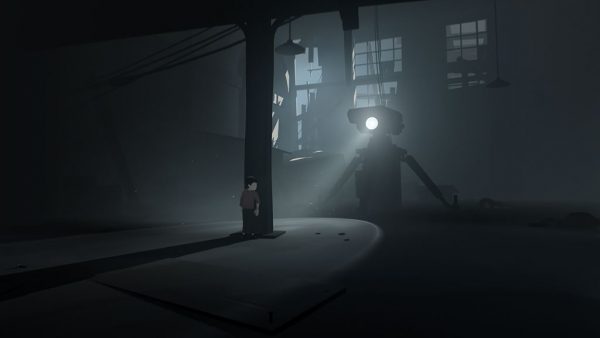Publisher: Playdead
Developer: Playdead
Medium: Digital
Players: 1
Online: No
ESRB: M
On one level, Inside kind of bugs me. Its main character is a kid on the run, which means, of course, that the entire narrative is built around the “child in peril” trope. A child being chased and tackled by large men. A child being run down by vicious dogs. A child falling to its death from great heights, drowning in dark, murky water, and simply being shot in cold blood.
In other words, the game evokes some pretty strong emotions in a way that, quite frankly, seems kind of cheap. I mean, I can barely tolerate children in real life, but every time the unnamed main character here died in some horrific way — or even found themselves on the verge of dying in some horrific way — I still found it pretty troubling. I know that that’s a normal, healthy way to react to, say, a child being savaged by a pack of dogs, but that doesn’t make it feel any less emotionally manipulative when you step back and think about it for a second.
Of course, on another level, if the worst thing I can say about Inside is, “It made me feel upset!”, that’s probably a sign that it achieved what it set out to do rather well. There’s certainly the argument to be made that it could’ve done this in a more complex or nuanced way, but it’s important to remember that we’re talking about a puzzle-platformer without cutscenes or exposition here. It’s a game that relies on action to tell a story; that it’s able to create any feelings at all in players is pretty impressive.
Also pretty impressive: literally everything else about Inside.
It’s as if Playdead looked at what made Limbo work so well, and then decided they were going to do all those things again, but better. They made the jump from only using dark colours to a full colour palette, yet kept the feeling of menacing dread that lurked all around the edges of Limbo’s more monochromatic world. They introduced more fully-realized enemies, and in the process showed how much more terrifying specificity can be. Likewise, it’s one thing to jump from one ledge to another in a vaguely factory-like setting; it’s another, in a way that’s altogether more frightening and real, when you’re jumping from rooftop to rooftop, or diving into murky water.
If there are any areas where Inside doesn’t show drastic improvement over its predecessor, it’s in the actual puzzle-solving and platforming …but seeing as Limbo did those things extremely well already, all Inside really needed to do was continue excelling in those areas, and it does. In fact, I personally found the puzzles here even more engaging, for reasons that go back to the last paragraph: because this game is set in a more realistic world, it doesn’t feel like you’re finding solutions in some abstract way. It’s less “push this dark block towards that dark wall”, and more “get this pig to chase you until it stuns itself against a wall, then use those zombie-like creatures to help you open the gate, and then climb over the shipping crate to the next puzzle.” (Note: Inside is more realistic than Limbo, but that doesn’t mean that it’s actually realistic.)
Basically, what I’m trying to say is that Inside excels in pretty much every way imaginable. When my biggest issue with the game is that it skimps a little on the storytelling, that should tell you how good it is overall. I wouldn’t have thought it possible that Playdead would follow up their first hit with a game that, somehow, is even better, but here’s Inside to show otherwise.



